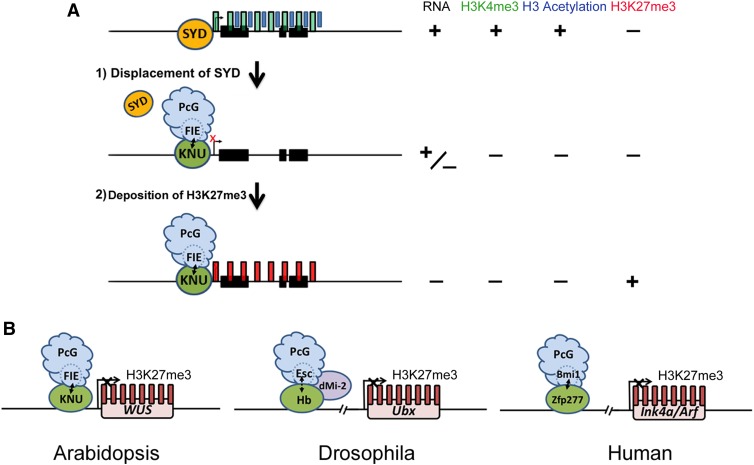Figure 10.
Models.
(A) Working model on how KNU represses WUS. Before stage 6, when the active histone marks H3K4me3 and H3 acetylation on WUS are detected, the active transcription of WUS is maintained by the SWI/SNF ATPase SYD. During the early floral stage 6, the KNU protein, which is induced by AG, may associate with PRC2 and the KNU-PRC2 complex directly binds to the WUS promoter by competing with SYD. That leads to eviction of SYD from the WUS promoter and a decrease in the active marks H3K4me3 and H3 acetylation. Both the repressor activity of KNU (mediated by histone deacetylation) and the eviction of SYD simultaneously lead to transcriptional repression of WUS. Subsequently, the KNU-PRC2 complex deposits the repressive mark H3K27me3 onto WUS, which is maintained by continuous expression of KNU after stage 6.
(B) A conserved mechanism for the recruitment of PcG to target genes by C2H2 zinc finger proteins in plants and animals. In Arabidopsis, the C2H2 zinc finger protein KNU binds to the WUS promoter and recruits PcG to WUS via direct interaction with FIE, a homolog of Esc of Drosophila. In Drosophila, the C2H2 zinc finger protein Hunchback (Hb), which binds the Ultabithorax (Ubx) promoter, together with dMi-2 recruits PcG to UBX via interaction with Esc. In human cells, the C2H2 zinc finger protein Zfp277, which binds the Ink4a/Arf locus, directly interacts with Bmi1, a PRC1 factor for PcG recruitment to Ink4a/Arf. (For simplicity, gene size and structures are not to scale.)

